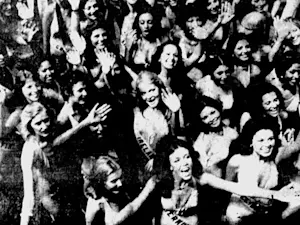
Inside Stanford's Infamous Prison Experiment
In 1971, a shocking psychology experiment spiraled out of control, revealing the terrifying effects of power on everyday people. College students, split into "guards" and "prisoners" in a fake prison, quickly descended into chaos — so much so that the study was abruptly cut short after just six days. But what really happened in that basement at Stanford? With new insights revealed, the story behind this notorious study is more disturbing than ever.
Creating a 'Prison' Environment
More than 70 young men responded to an ad for a "psychological study of prison life," with 24 participants selected for their mental and physical health. Participants were paid $15 per day and divided equally into groups of guards and prisoners. On Aug. 17, 1971, nine young men volunteered to be "arrested" by Palo Alto police and taken to a mock prison set up in Stanford University's psychology department basement. In line with Zimbardo's goal of simulating a real prison environment, guards were issued mirrored sunglasses to avoid eye contact and given uniforms and batons to convey authority. Prisoners wore gowns and chains around one ankle to create a sense of vulnerability.
Zimbardo and other researchers observed and recorded the behavior of participants, intending to capture how social expectations would shape their actions in the roles they had been assigned.
Guards' Behaviors and Influences
Within days, some guards began acting in harsh, even tyrannical ways, enforcing rules with severe punishments and creating a system of rewards to control the prisoners' behavior. One guard, Dave Eshelman, later described how he consciously adopted an abusive persona, treating the study as a performance. Zimbardo, who had initially planned to maintain a researcher's distance, found himself acting in the role of "prison superintendent," effectively enabling the guards' behavior by allowing it to continue.
Some prisoners resisted these pressures, staging a rebellion on the second day. However, guards quickly suppressed the uprising, leading to an increasingly oppressive environment.
The Experience of the Prisoners
The prisoners, though aware it was a study, showed signs of psychological strain as the immersive environment deepened. The use of uniforms and the strict roles quickly led many to internalize their "prisoner" identity. Some prisoners complied with guards' orders to avoid punishment, while others attempted passive resistance. Within the first four days, three prisoners had become so distressed that they were released. By the sixth day, an outside observer advised Zimbardo to end the study due to the evident psychological toll it was taking on participants.
 Prisoners in bed cell, 1971. Photo courtesy of Philip Zimbardo under CC BY-SA 4.0.
Prisoners in bed cell, 1971. Photo courtesy of Philip Zimbardo under CC BY-SA 4.0.
Criticism and Alternative Explanations
The Stanford Prison Experiment faced immediate criticism, both for its ethics and its methodology. Zimbardo later argued that the guards' actions were a result of the "social forces" and pressures created within the simulated prison. However, critics suggest that the initial advertisement — seeking participants for a "prison study" — may have attracted individuals already predisposed to authoritarian behavior. A 2007 study by psychologists Thomas Carnahan and Sam McFarland found that people drawn to participate in a prison study scored higher on traits like aggression and dominance, challenging the claim that the experiment reflected universal behavior.
In 2001, the BBC conducted a similar study without an authority figure guiding the guards. The BBC Prison Study, documented in a television series, found that the guards struggled to unify, while prisoners organized to resist. The contrasting outcomes led the British researchers to describe the Stanford Prison Experiment as "a study of what happens when a powerful authority figure imposes tyranny."
Lasting Legacy
The recent passing of Philip Zimbardo has renewed interest in the Stanford Prison Experiment and its legacy. Though aspects of the study remain controversial, it has left a lasting mark on psychology and popular culture, inspiring films like "Das Experiment" (2001) and "The Stanford Prison Experiment" (2015). Zimbardo's findings and his testimony before Congress helped shape discussions on prison reform and the effects of social environments on behavior.
 A plaque marking the site where the famous Stanford Prison Experiment was conducted. Photo courtesy of Eric. E. Castro under CC BY 2.0.
A plaque marking the site where the famous Stanford Prison Experiment was conducted. Photo courtesy of Eric. E. Castro under CC BY 2.0.
More than five decades later, the Stanford Prison Experiment remains a controversial chapter in psychology, raising unsettling questions about power, human behavior, and the influence of authority.
References: Stanford Prison Experiment | Philip Zimbardo, the psychologist behind the 'Stanford Prison Experiment,' dies at 91 | The Real Lesson of the Stanford Prison Experiment























